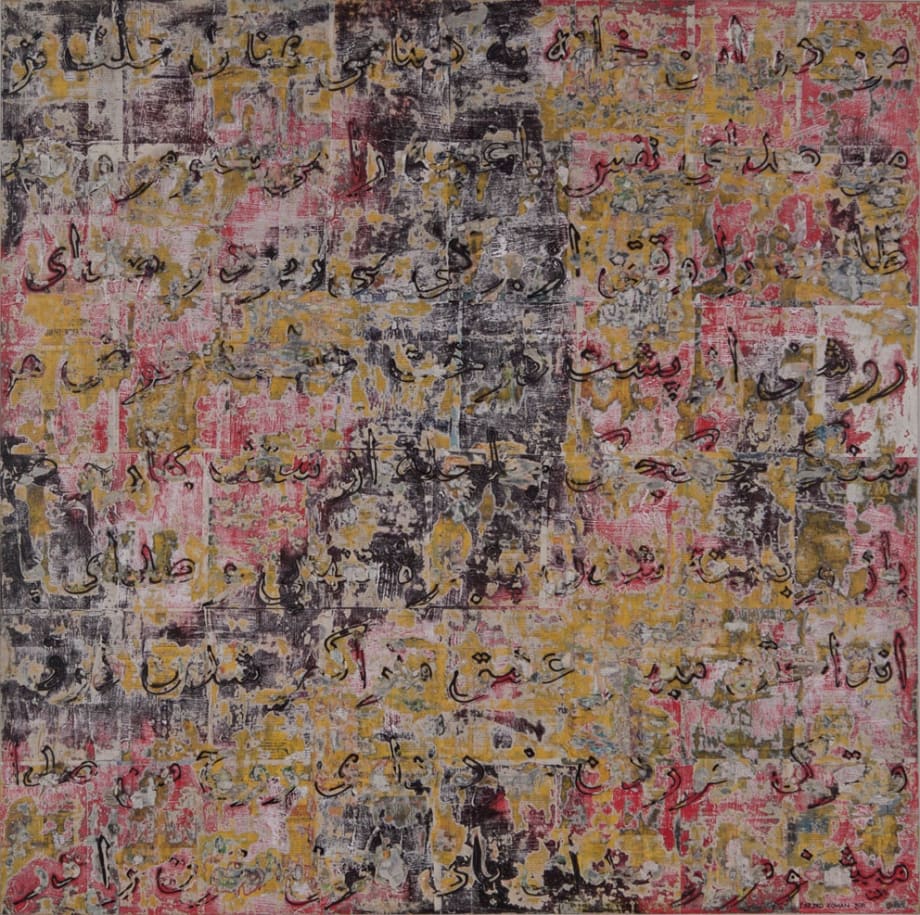Farzad Kohan’s sculptures and paintings explore themes like love, migration, and identity, and often incorporate appropriated media and found objects. Partially inspired by his personal history and surroundings, Kohan places an emphasis on form, allowing the successive stages of art making to become analogous to diasporic experience, as diverse, sometimes opposing, elements are sampled, brought together, and accumulated. These apparent stages are integral parts of each finalised work. Kohan’s formalistic process is revealed, for example, as he layers then strips abstract works through painting, collage, décollage, and sanding, creating built-up yet weathered surfaces that are at once chaotic and methodical. Allusions to the passage of time, gradual transformations, and hidden stories are found in the tactile details of his treated panels.
Text has also been central to Kohan’s compositions, as he uses Farsi or Arabic script to add narrative elements. In Love Letters, a series of works on paper, he describes moments of longing and desire with poetic confessions that are written across the lower portion of his compositions. The artist’s verses correspond with the colour schemes and textured surfaces of specific works, as abstraction is used to detail the different sensations of romantic love. With his most recent series of paintings, Kohan records the migration stories of others through excerpted texts or quotes that are written across the canvas in American typewriter font, as though creating an archival document. The forms of these untitled works are inspired by the very process of migration, and reflect the difficulties of assimilation with techniques that attempt to unify repellent materials like oil and water based media.
Alongside his sculptures and paintings, Kohan has experimented with installation, and also maintains a large body of works on paper that he expands on a daily basis. Although Kohan’s ink drawings reflect similar themes, their figures signal a representational departure for the artist, as the thin, black outline of a recurring man is delicately rendered and accentuated with Persian letters and numbers in addition to other enigmatic symbols.
Born in Tehran, Iran in 1967, Farzad Kohan lives and works in Los Angeles, California, where he first trained as a sculptor in the late 1990s. Kohan has held solo exhibitions at Ayyam Gallery, DIFC, Dubai (2016, 2013) and Seyhoun Gallery, Los Angeles (2006). Selected group exhibitions for the artist include Ayyam Gallery, Al Quoz 1, Dubai (2018); Arena 1 Gallery (Advocartsy), Los Angeles (2016, 2015); Mim Gallery, Los Angeles (2015); Ayyam Gallery, Beirut (2015); Francis Boeske Projects, Amsterdam (2015); ABRA Gallery, Los Angeles (2011); Human Rights Awareness Tour, USA (2008); J Ferrari Gallery, Los Angeles (2008); Eagle Rock Center for the Arts (2008); and Phantom Galleries, Los Angeles (2007).
Kohan’s works are held in private and public collections, including the Los Angeles County Museum of Art.
